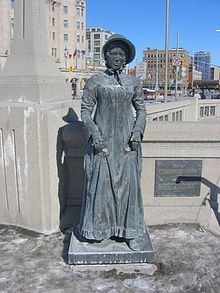Laura Secord
Laura Secord (born September 13, 1775 in Great Barrington ( Massachusetts ), USA ; † October 17, 1868 in Queenston ( Ontario ), Canada ) is a Canadian national heroine of the War of 1812 .
Life
Contrary to other information, Laura Ingersoll's father was not a loyalist , but fought against the British in the American War of Independence . In 1795 he emigrated with his family because of economic difficulties to Upper Canada , where the family settled on the Niagara Peninsula and ran an economy. Laura Ingersoll married James Secord from the USA in 1797 , who had been driven to Upper Canada as a loyalist. After the marriage, the couple lived in Queenston (now Ontario ) on the Niagara River . They had five children and made a modest affluence from a housewares business.
James Secord joined the Canadian militia during the 1812 War between the United States and Britain and was seriously wounded in the leg as a sergeant in the Battle of Queenston Heights in 1812 . In May 1813, the Americans again invaded Canada. The Secords were also forced to take on three US officers. On June 21, Laura Secord overheard a conversation that revealed the Americans were planning a surprise attack on a nearby British detachment under Lieutenant James FitzGibbon . Since her husband was too weak from his wound to do anything, she secretly left the house herself to warn FitzGibbon.
To get to its location, she had to hike 20 miles of impassable terrain in the scorching heat, including a six-hour climb through the hills of the Niagara layer . She always had to fear falling into the hands of an American patrol. After an eighteen hour hike - barefoot and bloody feet at the end - she met a group of the Mohawk Indians allied with the British , who took them the rest of the way to FitzGibbon. FitzGibbon was deeply impressed by her performance and later wrote that he could hardly believe that a petite woman like her could endure such hardships. The timely warning enabled him to set an ambush and defeat the vastly outnumbered US troops on June 24 at the Battle of Beaver Dams and force them to surrender. That defeat was one of the reasons the Americans evacuated the Niagara Peninsula in late 1813.
After the end of the war, the couple tried in vain for years to have their achievements officially recognized. This did not happen until 1860, when the then Prince of Wales Albert Edward, later King Edward VII , visited her at her home in Queenston and gave her £ 100. This was the only recognition she received in her lifetime. She died in 1868 at the age of 93.
Your reconstructed house is now a museum. The story of Laura Secord's walk has become popular in Canada and has received numerous embellishments. To this day, she is probably the most famous and popular woman in Canadian history. In 2003 she was declared a Person of National Historic Importance by the Canadian government . Her memory is also kept alive by a chocolate brand named after her.
Web links
- Laura Secord . In: Dictionary of Canadian Biography . 24 volumes, 1966–2018. University of Toronto Press, Toronto ( English , French ).
- Niagara Heritage Trail: The Story of Laura Secord (English)
- Gala film: Laura Secord (English)
- Laura Secord Homestead (Laura Secord Museum) (English)
- Detailed report on Laura Secords hike (English)
- Laura Secord chocolate (English or French)
notes
- ↑ see English Wikipedia: en: Persons of National Historic Significance , list
| personal data | |
|---|---|
| SURNAME | Secord, Laura |
| BRIEF DESCRIPTION | Canadian national heroine (in the war of 1812) |
| DATE OF BIRTH | September 13, 1775 |
| PLACE OF BIRTH | Great Barrington , Massachusetts, USA |
| DATE OF DEATH | October 17, 1868 |
| Place of death | Ontario , Canada |
